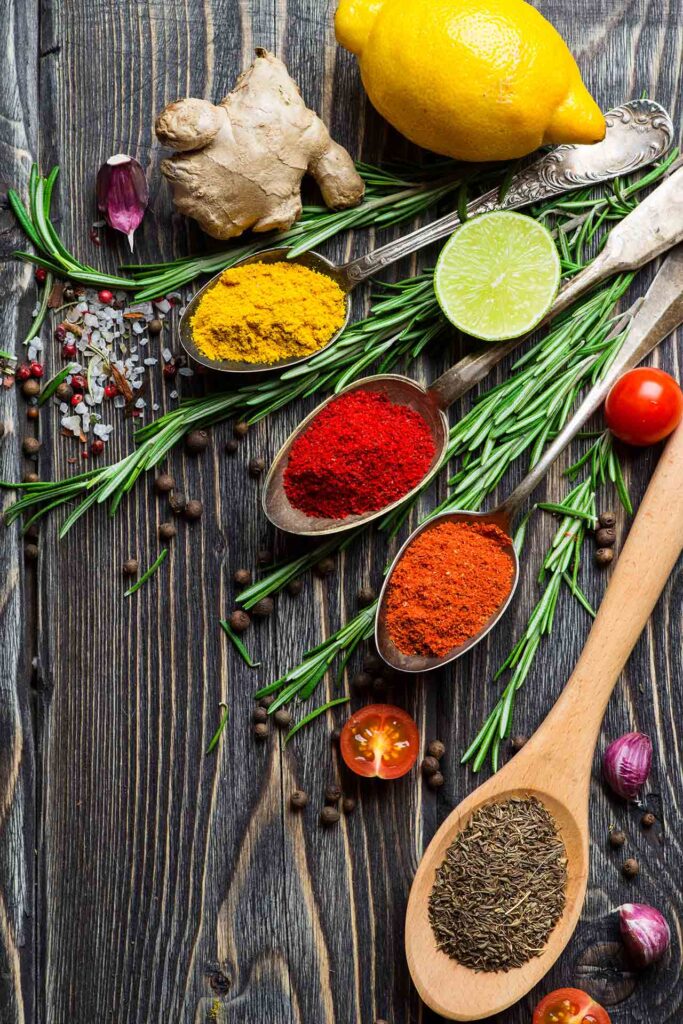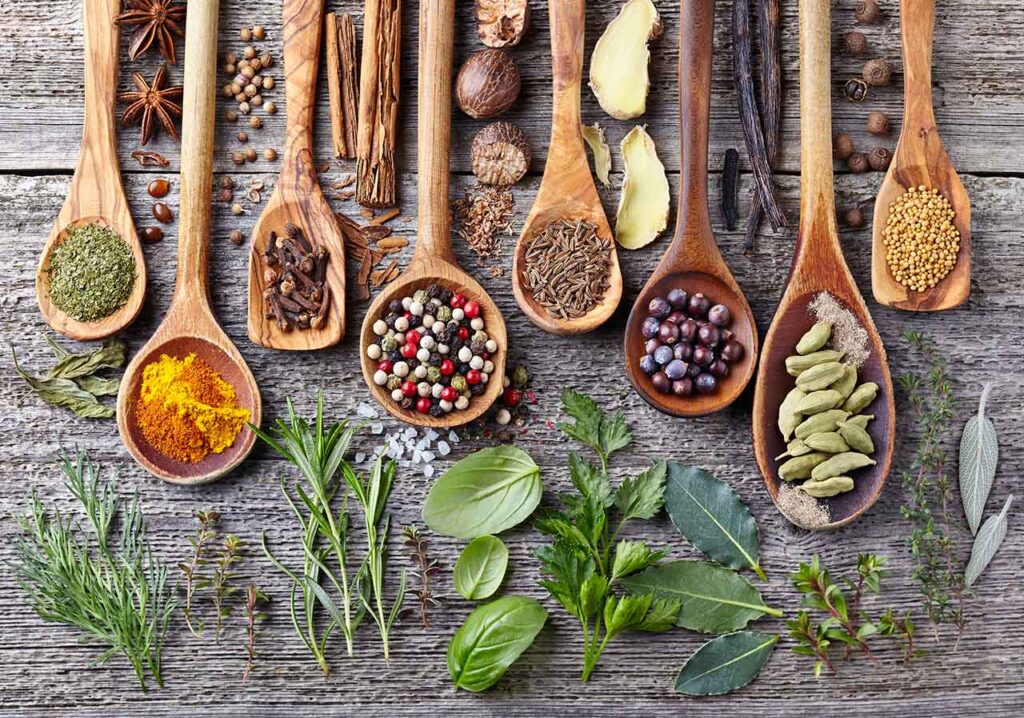How To Cook With Herbs and Spices
Herbs and spices have been used for thousands of years to heal what ails us and enhance the flavor of our foods. But what exactly are they, and how do you use them to cook with or store them properly?

What Are Spices?
The dictionary defines spices as: “an aromatic or pungent vegetable substance used to flavor food, e.g., cloves, pepper, or cumin.”
Generally speaking, they are parts of a plant that are flavorful. Sometimes it’s the leaves, sometimes it’s the roots, and sometimes it’s the seeds or a pod.
Spices were not always as readily available as they are today. Spice wars were fought for 200 years in the name of the spice trade. Wealthy men made their fortunes with spices centuries ago, and the allure of a well-spiced meal will show you exactly why they valued them so highly.
While now readily available worldwide, spices are specific to various regions and affect the cooking and flavors of the areas where they are grown. Thankfully, today, we can enjoy a readily available supply of spices, which allows us to enjoy Indian food in Japan or Chinese food in Alaska.
Herbs vs. Spices
While I will use the terms “herbs” and “spices” interchangeably here, it’s essential to understand that there is a difference between herbs and spices.
Generally speaking, herbs are typically fresh or dried leaves, while spices come from other parts of the plants, such as seeds, roots, or bark.
Examples of herbs are basil, thyme, and parsley. Examples of spices are cinnamon, cumin, and paprika.
Using Spices in Cooking
Spices do several things for us. They enhance our dishes’ flavors and aromas, add flavor depth, and allow us to make foods with their own cultural identities.
While cooking with herbs and spices can be an art form, it can also be a developed skill. It’s easy to follow a recipe and its measurements, but knowing what spice to use and how much you need based on how something tastes takes practice. The more herbs and spices you use in your cooking, the more you’ll understand what seasoning goes with which foods. Cooking anything can take practice.
Fresh Spices
If you prefer fresh herbs, you aren’t alone. Fresh herbs add wonderful flavor to any dish, particularly as a garnish. After all, what pizza isn’t improved by adding some fresh basil added on just before serving?
Use fresh herbs at three times the rate of dry spices. So, if a recipe calls for one teaspoon of dried parsley, you can use three teaspoons of fresh parsley, and of course, the reverse is also true. That said, some spices require a slightly different ratio. But the 3 to 1 balance is about right for most herbs and spices.
Dry Spices
Most of us have these in our kitchen cabinets or pantries. Whether it’s a bottle of garlic powder or a jar of dried basil, most folks who cook at home would never do so without some seasoning.
Dried herbs are a convenience. Drying them allows us to keep them for extended periods and through seasons when they don’t grow.
When To Use Spices
Believe it or not, there is a right and wrong time for adding spices in cooking. Different spiced release flavors at varying times once in your pot or pan.
Generally speaking, delicate herbs such as basil should be added towards the end of your cooking time, particularly fresh basil. Otherwise, you won’t be able to taste it in the dish.
More robust herbs and spices can be added earlier in the cooking process and can even be dry-roasted. Spices such as cumin do well with this.

Roasting Dried Spices
One way to bring out the flavors in your dried spices is to dry roast them before adding them to a dish. Dry roasting is a simple process involving using a dry, unoiled pan and your dry herbs. Place the spices in the pan and turn the heat to medium or medium-high heat. Stir your spices until the fragrance becomes very aromatic and smells up your whole kitchen nicely. Once you can smell the aroma, they are ready to be added to your dish and will add far more flavor than they would have if you had just dumped them into your main pot or dish straight from the spice jar.
How To Store Herbs and Spices
For the most part, you’ll want to keep dry spices in a dark cabinet. Keep them dry and make sure they don’t get too old. Old spices lose flavor, so rotate them occasionally, replacing the old with the new. It would be best if you also kept them in an airtight container.
Some seasonings we use are better off being stored in the freezer. Any spice blend containing seeds, such as sesame or poppy seeds, should be stored in the freezer. Storing them in the freezer will keep the seeds from turning rancid as quickly as they would if you just stuck the seasoning jar in your cupboard.
For fresh herbs, you’ll need a glass. Cut the bottom of the stems off of your herbs and place them in the glass. Fill the glass with enough water to come up just under where the leaves begin. Don’t submerge herb leaves in water because they will rot, and your herbs will go bad faster. Place a plastic bag (such as a produce bag) over the herbs and the glass, and set the whole thing in the fridge. Make sure the bag is closed. Depending on the herbs, Fresh herbs can last up to two weeks this way—sometimes even longer.
Best Spice Containers
To properly store your herbs and spices, you can keep them in the jar they came in, or, if you purchase bulk spices, store them in a glass jar for the best results. Canning jars are great for this and are easy to label as needed.
Making Your Own Spice Blends
Making spice blends is a quick and healthier way to season your food. It might be easy to grab a packet of taco seasoning at the store, but have you read the ingredient list lately? It’s not just spices they put in there.
It’s so fast and easy to make spice blends at home, and it might even save you some money. Taco season, for example, is one of the most straightforward seasoning blends to make, and it takes less than 2 minutes to do so, as long as you have the necessary spices in your cabinet. Hint: Most of us do.
For a while there, everyone was going crazy over the Everything Bagel Seasoning from Trader Joe’s. That is, until they realized they could easily make it at home. You get a much bigger yield than those tiny little jars at the store, so it’s always easy to have some on hand when you need some for your avocado toast or scrambled eggs. It’s even super tasty on roasted chickpeas. As mentioned above, this is one you’ll want to store in the freezer, and yes, you can use it straight from the freezer—no thawing required.
Spice blends are also great for making dry rubs for different meats. You can also turn them into marinades with oil and maybe some citrus juice. Dry rubs are a great way to get that proper depth of flavor we all love from the meats we enjoy.
Basic Spices To Stock Your Pantry With
If you are just starting out or need to redo your supply of dried spices, here is an essential list that will give you a good foundation to build your spice collection.
- Garlic granules or powder (not garlic salt) – An all-purpose seasoning
- Onion granules or powder – An all-purpose seasoning
- Dried parsley – Great for soups and stews
- Dried thyme – Great for soup, stews, and chicken
- Ground cumin – Works great for Latin dishes or in a pot of chili
- Chili powder – Great in a pot of chili or Latin dishes
- Paprika – Fantastic on deviled eggs and tasty as a general spice
- Ground rosemary – Wonderful on poultry and in Italian dishes
- Dried basil – Works in soups, stews, and Italian dishes
- Ground black pepper – An all-purpose seasoning
- Dried dill – Great for seafood
There are, of course, many more spices you can use in the kitchen and many more types of dishes you can use them in. But this essential list will get you started.
Buying and Sourcing Spices
We can all go to the grocery store and buy a bottle of herbs or spices. But you’ll get far more bang for your buck if you can find a way to buy your spices in bulk. Doing so also gives you an excellent opportunity to learn where your herbs are sourced from and to make your spice blends at home.
Many health food stores will carry spices in bulk. But a quick Google search will help you find a good supplier of good quality herbs and spices in your area. Sometimes, you may have to order them online, but getting better quality spices can be worth it.
Spice Up Any Dish
Herbs and spices can turn any bland dish into something spectacular. With proper use and application, spices can bring an entire world into your home kitchen. Use them wisely.
This article originally appeared on Pink When.


